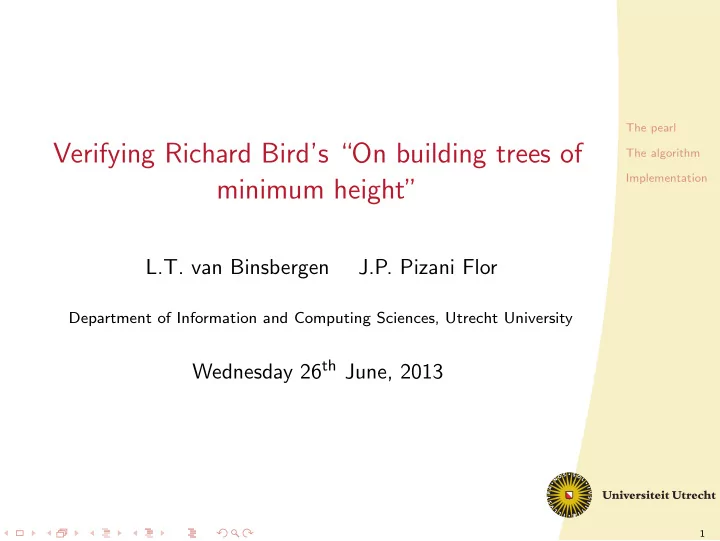

The pearl Verifying Richard Bird’s “On building trees of The algorithm Implementation minimum height” L.T. van Binsbergen J.P. Pizani Flor Department of Information and Computing Sciences, Utrecht University Wednesday 26 th June, 2013 1
“Combining a list of trees” The pearl The algorithm Given a list of trees, build a tree (of minimum height) that has Implementation the elements of the list as frontier (preserving order). ◮ We want to minimize cost , where cost means: cost t = (max i : 1 ≤ i ≤ N : depth i + h i ) ◮ depth i is the length of a path from root to tip i ◮ h i is the height of the i th element of the input list 2
Simpler but equivalent problem The pearl The algorithm The problem can be stated with natural numbers instead of Implementation trees being the elements of the input list. ◮ hs = [ h 1 , h 2 , . . . , h N ] ◮ Each element of the list is then considered the height of the tree. ◮ We use this “simplified” form of the problem in an example, but the “full” form is the one verified. 3
LMP - Local Minimum Pair The pearl The basis of the algorithm proposed is the concept of a “local The algorithm minimum pair”: Implementation ◮ A pair ( t i , t i +1 ) in a sequence t i (1 ≤ i ≤ N ) with heights h i such that: • max ( h i − i , h i ) ≥ max ( h i , h i +1 ) < max ( h i +1 , h i +2 ) ◮ An alternative set of conditions, used in the proof of correctness: • h i +1 ≤ h i < h i +2 , or • ( h i < h i +1 < h i +2 ) ∧ ( h i − 1 ≥ h i +1 ) 4
Greedy algorithm - example The pearl The algorithm Implementation ◮ There is at least one LMP, the rightmost one. ◮ The algorithm combines the rightmost LMP at each stage. ◮ Example in the whiteboard. . . 5
Correctness of the algorithm The pearl The correctness of this algorithm relies fundamentally on the The algorithm so-called “Lemma 1”: Implementation “ Suppose that ( t i , t i +1 ) in an lmp in a given sequence of trees t j (1 ≤ j ≤ N ). Then the sequence can be combined into a tree T of minimum height in which ( t i , t i +1 ) are siblings .” 6
Correctness of the algorithm The pearl The correctness of this algorithm relies fundamentally on the The algorithm so-called “Lemma 1”: Implementation “ Suppose that ( t i , t i +1 ) in an lmp in a given sequence of trees t j (1 ≤ j ≤ N ). Then the sequence can be combined into a tree T of minimum height in which ( t i , t i +1 ) are siblings .” ◮ In the paper, the proof of this lemma is done by contradiction and case analysis on whether the trees are critical . 6
Correctness of the algorithm How we expressed “Lemma 1” in Coq: The pearl The algorithm Theorem Lemma1: forall (l s : list tree) (a b : tree) Implementation (sub : l = [a;b] ++ s), lmp a b l -> exists (t : tree), siblings t a b -> minimum l t. Proof. Admitted. Fixpoint siblings (t : tree) (a b : tree) : Prop := match t with | Tip _ => False | Bin _ x y => a = x /\ b = y \/ siblings x a b \/ siblings y a b end. Definition minimum (l : list tree) (t : tree) : Prop := forall (t’ : tree), flatten t’ = l -> ht t <= ht t’. 7
The “build” function and foldl1 The “top level” function of the algorithm looks like this: The pearl build = foldl1 join . foldr step [] The algorithm Implementation ◮ The first big issue we face is how to describe a total version of foldl1 in Coq. 8
The “build” function and foldl1 The “top level” function of the algorithm looks like this: The pearl build = foldl1 join . foldr step [] The algorithm Implementation ◮ The first big issue we face is how to describe a total version of foldl1 in Coq. ◮ We modeled this by passing a proof that the list is non-empty: Definition foldl1 (f : tree -> tree -> tree) (l : list tree) (P : l <> nil) : tree. case l as [| x xs]. contradiction P. reflexivity. apply fold_left with (B := tree). exact f. exact xs. exact x. Defined. 8
Non-structural recursion in step The other BIG issue faced by us is the use of non-structural recursion in the function step : The pearl The algorithm step t [] = [t] step t [u] Implementation | ht t < ht u = [t,u] | otherwise = [join t u] step t (u : v : ts) | ht t < ht u = t : u : v : ts | ht t < ht v = step (join t u) (v : ts) | otherwise = step t (step (join u v) ts) We tried: ◮ “Function” keyword. ◮ Bove-Capretta • Termination predicate and step are mutually recursive . ◮ Define step using structural recursion on a natural n ≥ len ( l ). 9
Recommend
More recommend